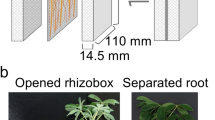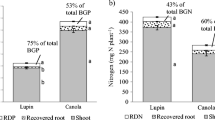Abstract
Background and aims
Biopores as microbial hotspots provide additional nutrients to crops – but only if their roots grow within the biopores. Such reuse has never been quantified as pre-crop-specific biopores are hardly differentiated from the multitude of pre-existing biopores. Quantification requires e.g. radionuclide labelling of pre-crops (137Cs, to label their biopores) and main crops (14C, to detect new roots). Preliminary testing was performed on simulated biopore reuse: both nuclides given to the same plant were excreted into the same rhizosphere.
Methods
Cichorium intybus (cv. Puna) and Medicago sativa (cv. Planet) were each sequentially labelled via the leaves with 137Cs and 14CO2. β-signals were visualised by imaging of horizontal soil cuts - with and without shielding off the weaker 14C.
Results
Both species allocated 7.1–9.4% of the 137Cs and 21–63% of the 14C below ground. The first image gave both activities; while the second gave only 137Cs. Subtracting the second from the first image gave the 14C distribution, resulting in successful separation of the signals. Thus, separate spatial representations of the roots were obtained. Main root locations by 137Cs and 14C showed a very high spatial overlap coefficient (> 0.95).
Conclusions
Biopore reuse quantification likely becomes feasible with this sequential labelling and shielding approach.






Similar content being viewed by others
References
Amato E, Lizio D (2009) Plastic materials as a radiation shield for β − sources. A comparative study through Monte Carlo calculation. J Radiol Prot 29:239–250
Athmann M, Kautz T, Pude R, Köpke U (2013) Root growth in biopores—evaluation with in situ endoscopy. Plant Soil 371:179–190
Banfield CC, Dippold MA, Pausch J, Hoang DTT, Kuzyakov Y (2017) Biopore history determines the microbial community composition in subsoil hotspots. Biol Fertil Soils 1–16. doi:10.1007/s00374-017-1201-5
Bolte S, Cordelières FP (2006) A guided tour into subcellular colocalization analysis in light microscopy. J Microsc 224:213–232
Buysse J, den Brande V, Karen MR (1995) The distribution of Radiocesium and potassium in spinach plants grown at different shoot temperatures. J Plant Physiol 146:263–267
Bystrzejewska-Piotrowska G, Urban PL (2004) Accumulation and translocation of cesium-137 in onion plants (Allium cepa). Environ Exp Bot 51:3–7
Bystrzejewska-Piotrowska G, Jeruzalski M, Urban PL (2004) Uptake and distribution of caesium and its influence on the physiological processes in croton plants (Codiaeum variegatum). Nukleonika 49:35–38
Carminati A (2013) Rhizosphere wettability decreases with root age: a problem or a strategy to increase water uptake of young roots? Front Plant Sci 4:298
Cheshire MV, Griffiths BS (1989) The influence of earthworms and cranefly larvae on the decomposition of uniformly 14C labelled plant material in soil. J Soil Sci 40:117–124
Cordelières FP, Bolte S (2009) JACoP v2.0: improving the user experience with co-localization studies. Proceedings of the 2nd ImageJ user and developer conference 2008:174–181
Cremers A, Elsen A, Preter PD, Maes A (1988) Quantitative analysis of radiocaesium retention in soils. Nature 335:247–249
Dippold MA, Kuzyakov Y (2016) Direct incorporation of fatty acids into microbial phospholipids in soils: position-specific labeling tells the story. Geochim Cosmochim Acta 174:211–221
Ehlers W, Köpke U, Hesse F, Böhm W (1983) Penetration resistance and root growth of oats in tilled and untilled loess soil. Soil Tillage Res 3:261–275
Elkins CB (1985) Plant roots as tillage tools. J Terrramech 22:177–178
Fernández V, Eichert T (2009) Uptake of hydrophilic solutes through plant leaves. Current state of knowledge and perspectives of foliar fertilization. Crit Rev Plant Sci 28:36–68
Fischer H, Ingwersen J, Kuzyakov Y (2010) Microbial uptake of low-molecular-weight organic substances out-competes sorption in soil. Eur J Soil Sci 61:504–513
Giannakopoulou F, Haidouti C, Chronopoulou A, Gasparatos D (2007) Sorption behavior of cesium on various soils under different pH levels. J Hazard Mater 149:553–556
Gunina A, Dippold MA, Glaser B, Kuzyakov Y (2014) Fate of low molecular weight organic substances in an arable soil: from microbial uptake to utilisation and stabilisation. Soil Biol Biochem 77:304–313
Hafner S, Kuzyakov Y (2016) Carbon input and partitioning in subsoil by chicory and alfalfa. Plant Soil 406:29–42
Hagedorn F, Bundt M (2002) The age of preferential flow paths. Geoderma 108:119–132
Han E, Kautz T, Perkons U, Uteau D, Peth S, Huang N, Horn R, Köpke U (2015) Root growth dynamics inside and outside of soil biopores as affected by crop sequence determined with the profile wall method. Biol Fertil Soils 51:847–856
Han E, Kautz T, Köpke U (2016) Precrop root system determines root diameter of subsequent crop. Biol Fertil Soils 52:113–118
Hasegawa M, Ito MT, Kaneko S, Kiyono Y, Ikeda S, Makino S (2013) Radiocesium concentrations in epigeic earthworms at various distances from the Fukushima nuclear power plant 6 months after the 2011 accident. J Environ Radioact 126:8–13
Hasegawa H, Tsukada H, Kawabata H, Takaku Y, Hisamatsu S (2015) Foliar uptake and translocation of stable Cs and I in radish plants. J Radioanal Nucl Chem 303:1409–1412
Hiltner L (1904) Über neuere Erfahrungen und Probleme auf dem Gebiete der Bodenbakteriologie unter besonderer Berücksichtigung der Gründüngung und Brache. Arbeiten der Deutschen Landwirtschaftlichen Gesellschaft 98:59–78
Hirth JR, McKenzie BM, Tisdall JM (2005) Ability of seedling roots of Lolium perenne L. to penetrate soil from artificial biopores is modified by soil bulk density, biopore angle and biopore relief. Plant Soil 272:327–336
Hoang DTT, Pausch J, Razavi BS, Kuzyakova I, Banfield CC, Kuzyakov Y (2016) Hotspots of microbial activity induced by earthworm burrows, old root channels, and their combination in subsoil. Biol Fertil Soils 52:1105–1119
Jones DL, Nguyen C, Finlay RD (2009) Carbon flow in the rhizosphere: carbon trading at the soil–root interface. Plant Soil 321:5–33
Kautz T, Amelung W, Ewert F, Gaiser T, Horn R, Jahn R, Javaux M, Kemna A, Kuzyakov Y, Munch J-C, Pätzold S, Peth S, Scherer HW, Schloter M, Schneider H, Vanderborght J, Vetterlein D, Walter A, Wiesenberg GL, Köpke U (2013) Nutrient acquisition from arable subsoils in temperate climates: a review. Soil Biol Biochem 57:1003–1022
Kuzyakov Y, Blagodatskaya E (2015) Microbial hotspots and hot moments in soil: concept & review. Soil Biol Biochem 83:184–199
Kuzyakov Y, Domanski G (2000) Carbon input by plants into the soil. Review. J Plant Nutrn Soil Sci 163:421–431
Kuzyakov Y, Raskatov A, Kaupenjohann M (2003) Turnover and distribution of root exudates of Zea mays. Plant Soil 254:317–327
Manders EM, Verbeek FJ, Aten JA (1993) Measurement of co-localization of objects in dual-colour confocal images. J Microsc 169:375–382
Meharg AA (1994) A critical review of labelling techniques used to quantify rhizosphere carbon-flow. Plant Soil 166:55–62
Miltner A, Bombach P, Schmidt-Brücken B, Kästner M (2012) SOM genesis: microbial biomass as a significant source. Biogeochemistry 111:41–55
Nucleonica GmbH (2014) Nucleonica Nuclear Science Portal (www.nucleonica.com). Karlsruhe, Germany. https://www.nucleonica.com/wiki/index.php?title=How_do_I_reference_Nucleonica_in_Scientific_Publications
Paterson E (2003) Importance of rhizodeposition in the coupling of plant and microbial productivity. Eur J Soil Sci 54:741–750
Pausch J, Kuzyakov Y (2011) Photoassimilate allocation and dynamics of hotspots in roots visualized by 14C phosphor imaging. J Plant Nutr Soil Sci 174:12–19
Razavi BS, Zarebanadkouki M, Blagodatskaya E, Kuzyakov Y (2016) Rhizosphere shape of lentil and maize. Spatial distribution of enzyme activities. Soil Biol Biochem 96:229–237
Riise G, Bjørnstad HE, Lien HN, Oughton DH, Salbu B (1990) A study on radionuclide association with soil components using a sequential extraction procedure. J Radioanal Nucl Chem Artic 142:531–538
Schindelin J, Arganda-Carreras I, Frise E, Kaynig V, Longair M, Pietzsch T, Preibisch S, Rueden C, Saalfeld S, Schmid B, Tinevez J-Y, White DJ, Hartenstein V, Eliceiri K, Tomancak P, Cardona A (2012) Fiji: an open-source platform for biological-image analysis. Nat Methods 9:676–682
Schindelin J, Rueden CT, Hiner MC, Eliceiri KW (2015) The ImageJ ecosystem: an open platform for biomedical image analysis. Mol Reprod Dev 82:518–529
Schuller P, Voigt G, Handl J, Ellies A, Oliva L (2002) Global weapons’ fallout 137 Cs in soils and transfer to vegetation in south–central Chile. J Environ Radioact 62:181–193
Stock D, Holloway PJ (1993) Possible mechanisms for surfactant-induced foliar uptake of agrochemicals. Pestic Sci 38:165–177
UNSCEAR (2011) Sources and effects of ionizing radiation. UNSCEAR 2008 report to the general assembly, with scientific annexes: volume II: effects, annex. D. United Nations, New York
VandenBygaart AJ, Protz R, Tomlin AD, Miller JJ (1998) 137 Cs as an indicator of earthworm activity in soils. Appl Soil Ecol 9:167–173
Walling DE, He Q (1999) Improved models for estimating soil erosion rates from cesium-137 measurements. J Environ Qual 28:611–622
Walling DE, Quine T (1995) Use of fallout radionuclide measurements in soil erosion investigations. In: IAEA (ed), nuclear techniques in soil plant studies for sustainable agriculture and environmental preservation. Proceedings of an international symposium on nuclear and related techniques in soil plant studies on sustainable agriculture and environmental preservation jointly org. By the IAEA and the FAO and held in Vienna, 17-21 October 19994. Vienna, pp 597–619
White RG, Kirkegaard JA (2010) The distribution and abundance of wheat roots in a dense, structured subsoil--implications for water uptake. Plant Cell Environ 33:133–148
Yunusa IAM, Newton PJ (2003) Plants for amelioration of subsoil constraints and hydrological control. The primer-plant concept. Plant Soil 257:261–281
Zarebanadkouki M, Ahmed MA, Carminati A (2016) Hydraulic conductivity of the root-soil interface of lupin in sandy soil after drying and rewetting. Plant Soil 398:267–280
Zhu YG, Smolders E (2000) Plant uptake of radiocaesium: a review of mechanisms, regulation and application. J Exp Bot 51:1635–1645
Acknowledgements
This study was supported by the German Research Foundation (KU 1184/29-1). We would like to thank Gabriele Lehmann and Rainer Schulz of the Laboratory for Radioisotopes (LARI) of the University of Goettingen for their advice, support and measurements.
Author information
Authors and Affiliations
Corresponding author
Ethics declarations
Conflicts of interest
The authors declare no conflicts of interest.
Additional information
Responsible Editor: Eric Paterson.
Electronic supplementary material
ESM 1
Leaf feeding of Cichorium intybus with 137CsCl solution in action (JPEG 501 kb)
ESM 2
Imaging of one Medicago sativa shoot, exposure was 3 h with 6 layers of polypropylene to shield off 14C, showing the mobility of 137Cs (GIF 225 kb)
ESM 3
Imaging of one Cichorium intybus shoot, exposure was 3 h with 6 layers of polypropylene to shield off 14C, showing the mobility of 137Cs (GIF 206 kb)
ESM 4
All replicates of the imaging of Medicago sativa. Top: Quantum level (QL) data of 137Cs and 14C activities; below: QL data for the 137Cs activity only (JPEG 813 kb)
ESM 5
All replicates of the imaging of Cichorium intybus. Top: Quantum level (QL) data of 137Cs and 14C activities; below: QL data for the 137Cs activity only (JPEG 755 kb)
ESM 7
A shielding and exposure pre-test with Hostaphan® film (to protect the imaging plate; left side) and Hostaphan® film plus 3 layers of polypropylene for shielding (right side). Activities increasing from 1 to 125 Bq of 14C–glucose were applied to coated paper. All 14C was shielded off (right side). Please note, the signals in case of higher 14C activities were visually discernible after shielding (right side; identifiers 7–11), but were in fact only marginally above the background value (36 PSL vs 21 PSL of the background). The number of PP films was increased after this test (JPEG 259 kb)
Rights and permissions
About this article
Cite this article
Banfield, C.C., Zarebanadkouki, M., Kopka, B. et al. Labelling plants in the Chernobyl way: A new 137Cs and 14C foliar application approach to investigate rhizodeposition and biopore reuse. Plant Soil 417, 301–315 (2017). https://doi.org/10.1007/s11104-017-3260-7
Received:
Accepted:
Published:
Issue Date:
DOI: https://doi.org/10.1007/s11104-017-3260-7




